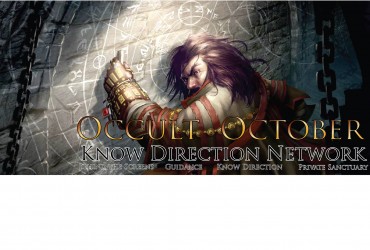Welcome to Guidance, Private Sanctuary’s source for tips and techniques for the Pathfinder Roleplaying Game, written by Everyman Gamer Alexander Augunas. Today, we’re going to be talking about ley lines.
One of the topics that Anthony and I were requested to cover in the Private Sanctuary was ley lines. Now, I love the concept of ley lines but Anthony and I agreed that talking about them for an hour would get boring fast, so I decided to give ley lines their due here as the final non-Iconic Design of Occult October! Let’s dive in and get this party started.
What’s a Ley Line?
The concept of a “ley line” has its routes as a historical overland path across the British Isles. The phrase was originally coined by an amateur archaeologist named Alfred Watkins in 1921; he used the term to reference the supposed alignments of places of historical and geographical interest across Europe, including ancient monuments, megaliths, natural ridge-tops, and water fords. He theorized that these ley lines were developed by the ancient Brits because they were easy places to trek overland.
Now, the term was pretty much that until 1969 when writer John Michel associated the term with spiritual and mystical theories about alignments of land forms, a sort of natural, terrestrial “feng shui,” if you would. They’ve been associated with everything from UFOs to magnetic fields to Atlantis in the real world, and countless fantasy stories have used them to represent the flow of natural magic across a landscape. This later definition is basically what Pathfinder uses in Occult Adventures.
Rules for Ley Lines
Two different rules for ley lines in Pathfinder exist; one set in Deep Magic by Kobold Press, the other in Occult Adventures. I haven’t had the time to explore Deep Magic’s take on the rules in-depth enough to know if they differ substantially from Paizo’s newer rules, but for the purpose of this article I’m going to stick with Paizo content.
Ley lines are describes as “the arteries that transport natural mysticism,” and each fittingly has a caster level (1st to 20th) that determines the amount of mystical energy that it carries. They span great distances, so in order to use a ley line one must find it first. Occult Adventures notes that many different divination spells can be used to learn about or locate a ley line, including detect magic (detect ley lines within the spell’s area) true seeing (detect all ley lines within an area you can see), and legend lore (learn about ley lines). One of the best methods to find ley lines is the dowsing occult skill unlock, which can detect ley lines across vast distances without the expenditure of spells or resources. Ley lines can also become visually manifested by ambient effects, such as areas of wild magic or negative energy affinity. Ley lines move, but they move slowly with the rotation of the planet. In that regard, they’re a bit like fault lines. When discovered, their presence is often marked by buildings and structures designed to channel their energy, such as pyramids and obelisks. These sites are often the seat of powerful occult rituals, but depending on the age of those buildings, however, those sites might be long disconnected from a ley line’s power.
Spellcasters are able to tap into ley lines in order to access their power using a process that takes 1 hour per 2 caster levels of the ley line. (To a maximum of 10 hours for a 20th level ley line.) Doing so requires a Spellcraft check with a DC equal to 20 + the ley line’s caster level, and success gives the caster a bonus to its caster level for all spells and spell-like effects equal to +1 plus an additional +1 per 5 caster levels of the ley line, for a massive +5 bonus on all level-dependent effects. That is SICK. The bonus is permanent too unless dispelled, such as by dispel magic.
Ley lines can be destroyed, but the only mortal means of doing so is mage’s disjunction. Doing so does a massive amount of damage to the caster, creates an antimagic field within 100 feet of the ley line’s area (which can be potentially HUGE), and has a high chance of permanently (and irrevocably) removing the caster’s ability to cast spells. The destruction of a ley line is beyond mortal means of repair, as is a character’s loss of spellcasting ability.
Ley Lines in the World
So, with this knowledge, how can you use ley lines in your game? First, the most important part is that a ley line should NEVER be willy-nilly. It might be tempting to justify a whole bunch of minor ley lines in your campaign world, but you risk believability like that. My suggestion is to make a map. Know where your ley lines are in your world, and make sure to have an assortment of high-level and low-level ley lines. Low-level ones are likely to be pretty common while high-level ones should be rare, the veritable western winds of magic.
Next, wherever a major ley line resides, SOMETHING interesting should be there. A highly advanced magical city, ancient ruins designed to channel the ley line’s power, a portal to another world, SOMETHING cool needs to be at the most powerful ley line spots. This adds believability to your ley lines.
Finally, if you’re going to include ley lines in a story, they need to be important. They can’t just be filler. Maybe the bad guys need the ley lines to fuel an occult ritual. Maybe they’re using it to power a doomsday weapon. Maybe they designed to set their base up next to a ley line simply to enhance their powers and are currently protecting said ley line. Whatever the reason, there needs to BE one.
Finally, the most important point: do not introduce ley lines if you’re afraid of giving the massive caster level boost to players. Expect your players to want to cash in on that wellspring of magical power, and take it into account when you design stuff.
And with that, I must leave you to prepare the final Occult October podcast for the Private Sanctuary Podcast! What did you think of today’s article? Where do you know the concept of ley lines from, and are you a fan of them in your game as a game mechanic? Why or why not? I look forward to your stories as well as your presence for the next installment of Guidance! Take care!
Alexander “Alex” Augunas has been playing roleplaying games since 2007, which isn’t nearly as long as 90% of his colleagues. Alexander is an active freelancer for the Pathfinder Roleplaying Game and is best known as the author of the Pact Magic Unbound series by Radiance House. Alex is the owner of Everyman Gaming, LLC and is often stylized as the Everyman Gamer in honor of Guidance’s original home. Alex also cohosts the Private Sanctuary Podcast, along with fellow blogger Anthony Li, and you can follow their exploits on Facebook in the 3.5 Private Sanctuary Group, or on Alex’s Twitter, @AlJAug.





